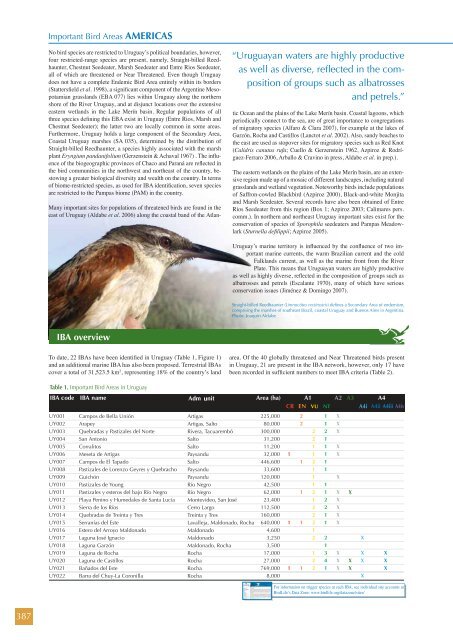Important Bird Areas AMERICAS - BirdLife International
Important Bird Areas AMERICAS - BirdLife International
Important Bird Areas AMERICAS - BirdLife International
Create successful ePaper yourself
Turn your PDF publications into a flip-book with our unique Google optimized e-Paper software.
No bird species are restricted to Uruguay’s political boundaries, however,<br />
four restricted-range species are present, namely, Straight-billed Reedhaunter,<br />
Chestnut Seedeater, Marsh Seedeater and Entre Rios Seedeater,<br />
all of which are threatened or Near Threatened. Even though Uruguay<br />
does not have a complete Endemic <strong>Bird</strong> Area entirely within its borders<br />
et al.<br />
potamian grasslands (EBA 077) lies within Uruguay along the northern<br />
shore of the River Uruguay, and at disjunct locations over the extensive<br />
eastern wetlands in the Lake Merín basin. Regular populations of all<br />
<br />
Chestnut Seedeater); the latter two are locally common in some areas.<br />
Furthermore, Uruguay holds a large component of the Secondary Area,<br />
Coastal Uruguay marshes (SA 035), determined by the distribution of<br />
Straight-billed Reedhaunter, a species highly associated with the marsh<br />
plant Eryngium pandanifolium (Gerzenstein & Achaval 1967) <br />
<br />
the bird communities in the northwest and northeast of the country, bestowing<br />
a greater biological diversity and wealth on the country. In terms<br />
<br />
are restricted to the Pampas biome (PAM) in the country.<br />
Many important sites for populations of threatened birds are found in the<br />
east of Uruguay (Aldabe et al. 2006) along the coastal band of the Atlan-<br />
<br />
<br />
and an additional marine IBA has also been proposed. Terrestrial IBAs<br />
cover a total of 31,523.5 km 2 , representing 18% of the country’s land<br />
<br />
UY001<br />
UY002<br />
UY003<br />
UY004<br />
UY005<br />
UY006<br />
UY007<br />
UY008<br />
UY009<br />
UY010<br />
UY011<br />
UY012<br />
UY013<br />
UY014<br />
UY015<br />
UY016<br />
UY017<br />
UY018<br />
UY019<br />
UY020<br />
UY021<br />
UY022<br />
<br />
<br />
<br />
<br />
<br />
<br />
<br />
<br />
<br />
<br />
<br />
<br />
<br />
<br />
<br />
<br />
<br />
<br />
<br />
<br />
<br />
<br />
<br />
<br />
<br />
<br />
<br />
<br />
<br />
<br />
<br />
<br />
<br />
<br />
<br />
<br />
<br />
<br />
<br />
<br />
<br />
<br />
<br />
<br />
<br />
<br />
<br />
<br />
tic Ocean and the plains of the Lake Merín basin. Coastal lagoons, which<br />
periodically connect to the sea, are of great importance to congregations<br />
of migratory species (Alfaro & Clara 2007), for example at the lakes of<br />
Garzón, Rocha and Castillos (Lanctot et al. 2002). Also, sandy beaches to<br />
the east are used as stopover sites for migratory species such as Red Knot<br />
(Calidris canutus rufa; Cuello & Gerzenstein 1962, Azpiroz & Rodríguez-Ferraro<br />
2006, Arballo & Cravino in press, Aldabe et al. in prep.).<br />
The eastern wetlands on the plains of the Lake Merín basin, are an extensive<br />
region made up of a mosaic of different landscapes, including natural<br />
grasslands and wetland vegetation. Noteworthy birds include populations<br />
of Saffron-cowled Blackbird (Azpiroz 2000), Black-and-white Monjita<br />
and Marsh Seedeater. Several records have also been obtained of Entre<br />
Rios Seedeater from this region (Box 1; Azpiroz 2003; Calimares pers.<br />
comm.). In northern and northeast Uruguay important sites exist for the<br />
conservation of species of Sporophila seedeaters and Pampas Meadowlark<br />
(; Azpiroz 2005).<br />
<br />
portant marine currents, the warm Brazilian current and the cold<br />
Falklands current, as well as the marine front from the River<br />
Plate. This means that Uruguayan waters are highly productive<br />
<br />
albatrosses and petrels (Escalante 1970), many of which have serious<br />
conservation issues (Jiménez & Domingo 2007).<br />
<br />
<br />
<br />
area. Of the 40 globally threatened and Near Threatened birds present<br />
in Uruguay, 21 are present in the IBA network, however, only 17 have<br />
<br />
<br />
<br />
<br />
<br />
<br />
<br />
<br />
<br />
<br />
<br />
<br />
<br />
<br />
<br />
<br />
<br />
<br />
<br />
<br />
<br />
<br />
<br />
1<br />
1<br />
1<br />
2<br />
2<br />
1<br />
1<br />
1<br />
1<br />
2<br />
2<br />
1<br />
1<br />
2<br />
1<br />
1<br />
1<br />
2<br />
1<br />
2<br />
2<br />
2<br />
1<br />
2<br />
1<br />
2<br />
2<br />
1<br />
1<br />
2<br />
1<br />
1<br />
1<br />
1<br />
1<br />
1<br />
1<br />
2<br />
2<br />
1<br />
1<br />
2<br />
1<br />
3<br />
4<br />
1<br />
X<br />
X<br />
X<br />
X<br />
X<br />
X<br />
X<br />
X<br />
X<br />
X<br />
X<br />
X<br />
X<br />
X<br />
<br />
<br />
X<br />
X<br />
X<br />
X<br />
X<br />
X<br />
X<br />
X<br />
X<br />
X

















